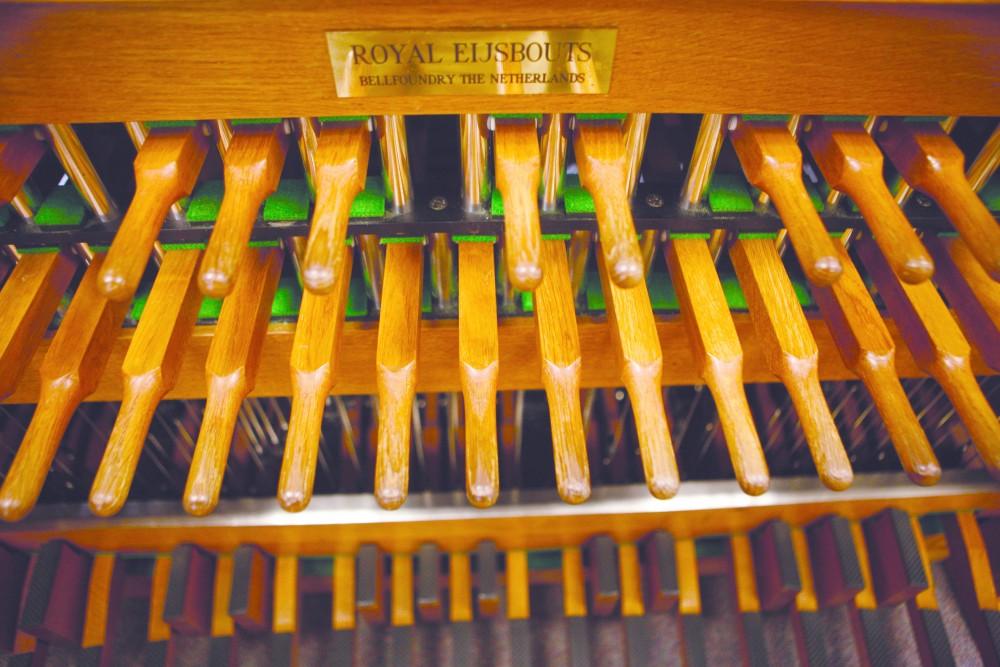Behind the scenes of the Cook Carillon Clock Tower

GVL/ Eric Coulter Julianne VanWynengaurd
Sep 15, 2011
The Cook Carillon Tower is a familiar part of life at Grand Valley State University, used at Convocation, Commencement, recitals, special events and, of course, to tell the time. While the time strikes are automated, carillon player and GVSU music professor Julianne Vanden Wyngaard is responsible for filling the Allendale air with music the rest of the time.
After working at GVSU for many years teaching piano, Vanden Wyngaard began studying the carillon in 1997 at the urging of then- resident Don Lubbers, who told the music department of his plans to construct the Cook Carillon Tower.
“It seemed a natural (fit), probably because of its likeness to the piano,” Vanden Wyngaard said. “…I can’t say that I was pushed into it, but I’m really glad the opportunity presented itself and that I was smart enough to step into it.”
She began her studies with a carillon professor at the University of Michigan and, over the course of four summers in the Netherlands, she completed her diploma requirements for the carillon in 2000. The carillon itself is set up somewhat like a piano, with two levels of batons like the black and white keys of a piano and a full radiated pedal keyboard below replicating the first two octaves of the carillon. Carillon sheet music looks like piano sheet music, with the treble clef played by a “loosely closed fist” and the bass clef played with the foot pedals. Each baton is connected to a bell clapper, which strikes the bells to produce notes. But unlike a piano, carillon bells are tuned at the casting factory and do not need to be tuned again for roughly 50 to 75 years.
Vanden Wyngaard said while the technology used to cast carillon bells has remained largely unchanged since the 14th or 15th century, the purpose of carillon bells has evolved over time.
“In Europe, often these carillons are at city gates from the days when the city gates closed at night and there was a curfew,” she said. “The people in the city would get their information from whatever was being told on the bells. It could be that someone died… They could announce that the enemy was approaching from the west, because they were very tall towers so they could see, or weather or whatever. But it was sort of like a town crier or a newspaper.”
Both the Cook Carillon Tower on the Allendale Campus and the Beckering Family Carillon on the Pew Campus have 48 bells encompassing four octaves and can play most literature composed for the carillon. The Cook Carillon Tower bells are Dutch, while the Beckering Family carillon bells are French. Vanden Wyngaard said the difference in origin produces slight differences in sound between the two towers.
“Each bellmaker thinks they have the answer to the recipe for the metal that goes into the bells, so those bells down there (on the Pew Campus) do sound just a tiny bit different than these (in Allendale),” she said. “It’s a slightly warmer sound than these bells out here (in Allendale), but the treble bells here, I think they are so clean and clear.”
Vanden Wyngaard said students are “very curious” about the carillon towers and the university’s open tower events always attract sizable crowds of students lining up to get a glimpse inside.
In addition to playing on both GVSU campuses, Vanden Wyngaard also performs carillon recitals around the country, including at the National Cathedral, Arlington Cemetery and across many different states. She said one of her most memorable performances was playing at Arlington Cemetery the summer after 9/11.
“They were still working on the Pentagon and from up there (in the bell tower)…if you look down to the left, you see the Pentagon kind of out in the distance, but you can see the side where all of the damage was inflicted so that was especially meaningful,” she recalled. “Then to the right, the Iwo Jima Memorial is there, where they’re raising the flag, so (it was) a moment of patriotism… That was really a fun and really nice experience.”
Vanden Wyngaard also looks forward to performing later this year at a carillon festival at the historic Bok Sanctuary in Lake Wales, Fla., which she called “the Taj Mahal” of carillon towers. “She accepted the challenge of learning a new instrument and is recognized as one of the nation’s leading players of this marvelous instrument,” said Gayle Davis, GVSU provost, in a press release.
Vanden Wyngaard also teaches students how to play the carillon as part of a two-credit course offered by GVSU, consisting of one 30-minute lesson each week on the electronic carillon in her office plus practice sessions in the Cook Carillon Tower itself and a final playing exam. Vanden Wyngaard currently teaches the carillon to two students but is always searching for more, regardless of major. Students interested in enrolling in the carillon course for the Fall 2012 semester may contact Vanden Wyngaard at [email protected].
In 2003, a garden near the Cook Carillon Tower was dedicated to Vanden Wyngaard. Christened “de Luisterplaats,” the garden’s Dutch name roughly translates to “the listening place.” Vanden Wyngaard said she is proud of what an important and recognizable symbol the carillon tower has become for GVSU.
“It has really become a focal point for the university,” she said. “You see it on all our papers and any print matter we have… It’s been a big contribution to just how the campus looks.”






















